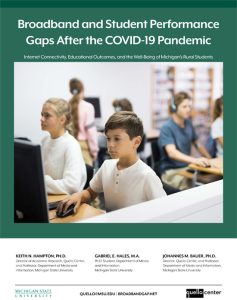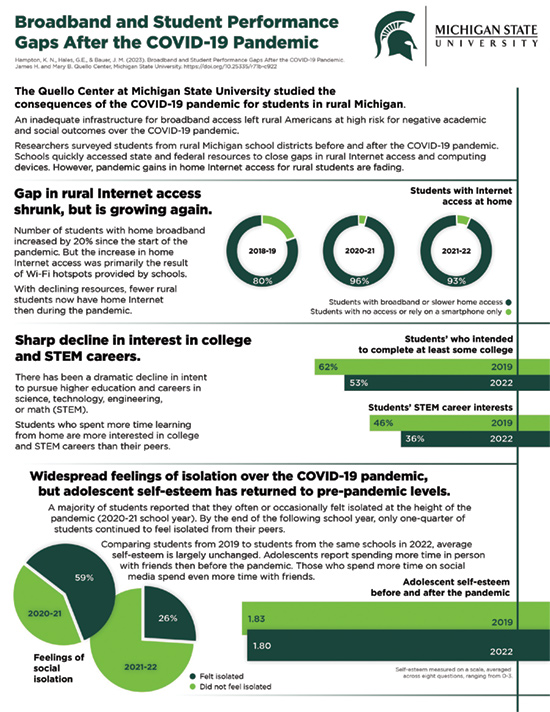Background & Motivation
The COVID-19 pandemic rapidly changed how Americans viewed the importance of broadband Internet connectivity. In a short period of time, a national emergency shifted how and where people accessed work and education, how they interacted with friends and family, and how they spent their time. An inadequate infrastructure for broadband access left rural Americans and particularly rural youth at higher risk. This study was designed to assess the impact of the COVID-19 pandemic on home Internet connectivity, student achievement, and adolescent well-being. The focus is on middle and high school students enrolled in rural and small-town schools.
This report builds on the findings of a study on Broadband and Student Performance Gaps released in the weeks before the start of the COVID-19 pandemic (Hampton et al., 2020). That report highlighted the low levels of broadband access by rural Michigan students and the detrimental impact from a lack of access on their academic performance, educational aspirations, career choices, and general well-being. In 2022, we returned to the same schools that we first surveyed in 2019. We asked students about their experience with Internet technologies and with learning from home during the pandemic. Our findings paint a picture of how rural school districts and other stakeholders rapidly mobilized to address a national crisis. In a remarkably short period of time, schools accessed state and federal resources to close gaps in rural Internet access and computing devices.
Key Findings
At the height of the COVID-19 pandemic, during the 2020-21 school year, the vast majority of rural Michigan students spent considerable time learning from home like many students across the country. Our findings show that students with better home Internet access experienced fewer problems learning from home. We found evidence that learning from home boosted students’ competencies with digital technologies. It also helped insulate some students from a broad pandemic decline in career interests related to science, technology, math, and engineering (STEM). During the COVID-19 pandemic, learning from home did not, however, protect students from a large drop in intention to pursue post-secondary education at a college or university. Although students reported exceptionally high feelings of isolation during the pandemic, these feelings have rapidly diminished. We found no substantive difference in young people’s self-esteem in comparison to before the pandemic. Young people are now spending more time in person with their friends than they did in the years before the pandemic. As youth leisure activities shifted, we also found that those young people, who spend more time using a variety of media, especially social media, are spending the most time in person with friends.
Method
This study is based on data collected in 2019 and 2022. In April and May 2022, we administered a twenty-minute, pen-and-paper survey to 2,949 students in eighteen rural Michigan schools. This procedure mirrored our efforts in the spring of 2019, when we surveyed 2,876 students in these same schools. In 2022, 72.3 percent of students enrolled in grades 8-11 completed our survey; in 2019 70.6% of students participated.
Contact
Dr. Keith N. Hampton: khampton@msu.edu | +1.517.432.6747
Dr. Johannes M. Bauer: bauerj@msu.edu
Quello Center: quello@msu.edu | +1.517.432.8005
Recommended Citation
Hampton, K. N., Hales, G.E., & Bauer, J. M. (2023). Broadband and Student Performance Gaps After the COVID-19 Pandemic. James H. and Mary B. Quello Center, Michigan State University.


